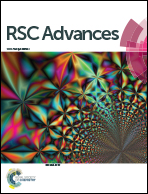Direct enantioseparation of 1-(2-hydroxyphenyl) ethylamines via diastereomeric salt formation: chiral recognition mechanism based on the crystal structure†
Abstract
In this study, the direct enantioseparation of unprotected 1-(2-hydroxyphenyl)ethylamines (1a and 1b) via diastereomeric salt formation is reported. After the one-pot synthesis of racemic 1, the screening of seven acidic chiral resolving agents showed that the extraction of (S)-naproxen (6) with dibenzoyl-L-tartaric acid (5) afforded the corresponding 1 : 1 diastereomeric salts that were suitable for the resolution of 1a and 1b. The optimization of the solvents resulted in high efficiencies for the resolution of 1a·6 in aqueous alcohols, which was consistent with the fact that the incorporated water molecules in the less-soluble diastereomeric salt reinforced its hydrogen-bonding network. For the efficient enantioseparation of rac-1b with 5, the intramolecular CH⋯O hydrogen bond played an important role in the chiral recognition.


 Please wait while we load your content...
Please wait while we load your content...